Over the past decade, the architectural, construction, and engineering (AEC) sector has grappled with unprecedented technological and socioeconomic changes, along with an unprecedented confluence of challenges to the health of our communities, our cities, and our planet. Climate change is accelerating—the decade leading up to 2020 was the warmest decade on record.1 Buildings and their construction account for 39 percent of global carbon dioxide emissions.2 At the same time, the built environment is growing at a record pace in the United States. It is estimated that 2.5 million new housing units are needed to make up for the nation’s housing shortage3, a trend that has not abated in the face of a global pandemic4. Economically, the price of housing has eclipsed the income of many Americans—precipitating a critical housing crisis in some regions—and adding to inequality and a rising homeless population across the nation.5 Amidst this, we spend as much as 90 percent of our time indoors, often cut off from nature6.
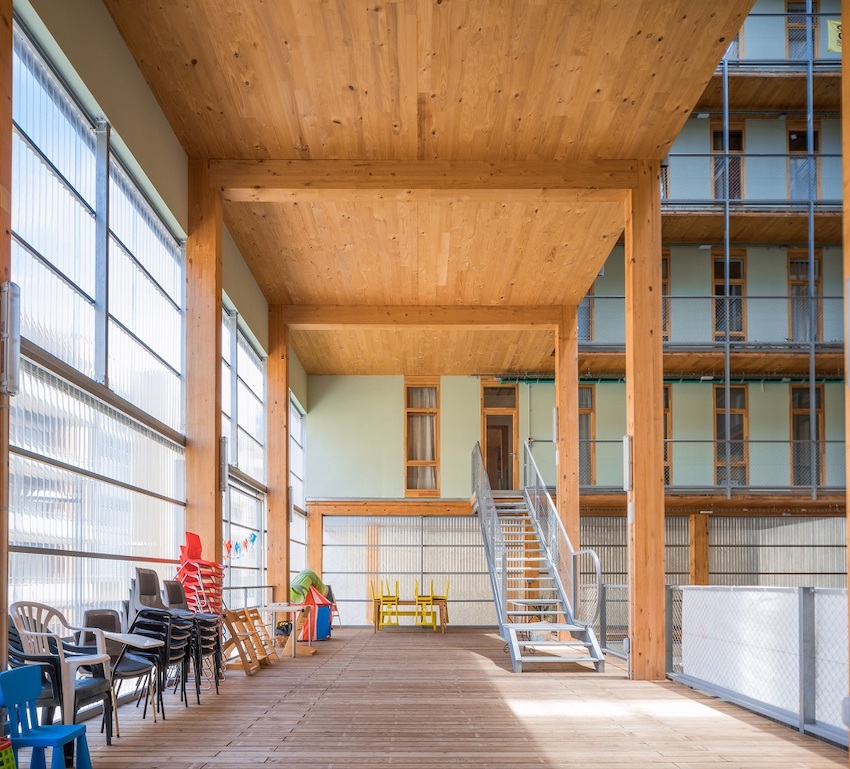
Photo courtesy of Lluc Miralles, courtesy Lacol Arquitectura Cooperativa
While these challenges are daunting, thought leaders in the AEC industry increasingly see it as an opportunity to be at the forefront of change, with examples of design leadership across the country and around the world. Technological gains within the built environment are making zero-carbon construction attainable7, dramatic energy savings achievable8, and taller mass timber construction possible9. Industry research, along with bold demonstration projects, is expanding the sector’s understanding of carbon sequestration, life cycle assessment (LCA), Passive House principles, and biophilic and health-centered design.
Four design approaches are leading the industry’s response to these challenges and opportunities:
Incorporating Greenspace
- Boosting health, resilience, and well- being by including greenspaces in project designs
A Focus on Community Building and Placemaking
- Lessons and learnings of community- centered, participatory design
Lowering Building Carbon Footprints
- Redesigning the built environment to mitigate climate change
Designing for Density and Affordability
- Boosting urban density and affordability through creative means
In this course you’ll learn from design teams who are embracing these strategies and delivering solutions that begin to address some of the most pressing global challenges of our times.
Greenspace: A Natural Prescription For Healthier Cities
Take a Walk in the Woods and Call Me in the Morning
A healthy city is a green city; a healthy urban dweller, a park-goer. There is ever growing evidence10 that local access to greenspace and green views positively impacts physical health, mental well-being, and the overall resilience of a city (defined as its capacity to survive, adapt, and grow in the face of adversity).11
Easy access to greenspace, urban parks, and nature has been linked to improved human health—everything from better immune function, mental health, and cognitive capacity to a reduction in type 2 diabetes and cardiovascular morbidity. Proximity to greenspace has been correlated with lower rates of psychiatric disorders.12 Beyond this, a city of well-connected, attractive greenspaces may be better equipped to bounce back from crises, natural disasters, and extreme weather events. These benefits extend to all population groups, particularly marginalized and low-income segments.
The science is still emerging13 and more research is needed, but initial findings and anecdotal reports show promising results. A walk in the woods may be just what the doctor ordered.
Density Isn’t the Problem; Equitable Access to Greenspace Is
Increasing equitable access to greenspace may be the biggest hurdle to countering crowding and creating more resilient cities. In the U.S. alone, 100 million people (28 million children included) do not have a neighborhood park within a 10-minute walk from home. The good news is that progress is being made. It’s part of a concerted effort called the 10-Minute Walk, a nationwide movement championed by The Trust for Public Land, the National Recreation and Park Association, and the Urban Land Institute. The program is enlisting mayors across the nation to improve access to parks and greenspaces.
It Takes a Green Village: Weaving Greenspace and Nature into the Built Environment
Along with increasing equitable access to public parks and recreational amenities, urban designers and architects in cities across the country are increasingly looking for innovative ways to weave greenspace into the built environment. Gardenhouse: Recreating a Hillside Village in an Urban Context Gardenhouse, a mixed-use, multifamily project in Los Angeles is a recent example of this trend, making the integration of greenspace central to its design. Conceived by MAD Architects to feel like a naturally vegetated hillside village, the 18 residential units, completed in late summer, feature the country’s largest green wall of its kind.
With seamless transitions between indoors and out, members of the Gardenhouse community enjoy expansive, open-concept floor plans with towering window walls and outdoor living spaces. Gruen Associates, who served as both the executive architect and landscape architect for the project, worked closely with the designers to bring a vision of nature-infused urban living to life.
The multifamily residence includes a purposeful mix of housing types to encourage a diverse community feel: two studios, eight condominiums, three townhouses, and five villas. The development’s concrete podium is crowned with a shimmer of white pitched-roofed units constructed of light-frame wood construction, while the interior finishes pay tribute to California’s woodworking heritage. A second-floor courtyard forms a central landscaped gathering space for the complex.
In many respects, the development acts as a demonstration project of what is possible. “Gardenhouse represents a unique opportunity to impact not only the architecture of Los Angeles but to introduce a new paradigm of living where humans are more emotionally connected to nature, particularly in high-density cities like Los Angeles,” said Ma Yansong, founder of MAD Architects.
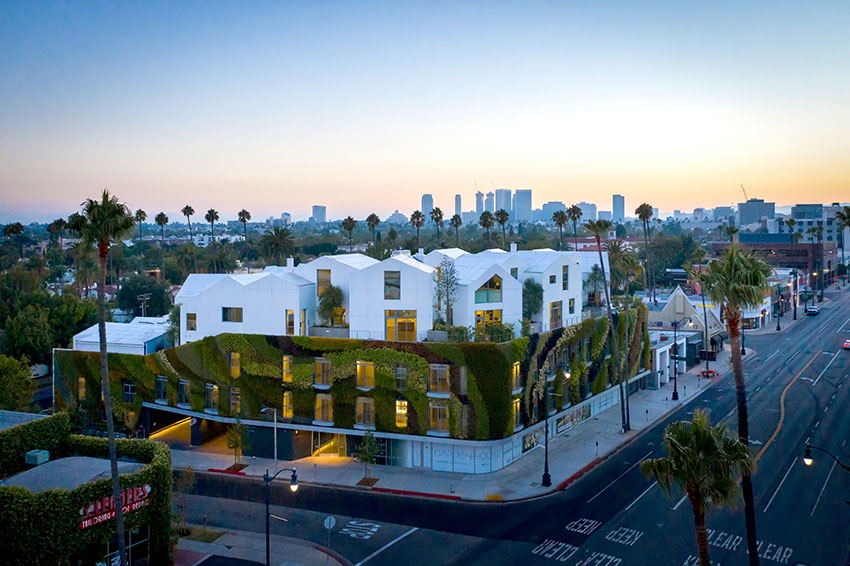
Photo courtesy of ©2013 Darren Bradley, courtesy MAD
Gardenhouse
Drs. Julian and Raye Richardson Apartments: Bringing the Healing Power of Nature to Transitional Housing
Biophilic design and greenspace are also connecting marginalized communities with the healing power of nature. One notable example is the Richardson Apartments complex in San Francisco. The 120 residential studio units, combined with common areas and program space, provide accommodation to formerly homeless individuals.
The architect used wood as the primary structural material because of its relative cost savings compared to concrete and steel. Wood was also left exposed throughout the interiors to add warmth, variety, and texture to the common spaces.
The social housing is complemented by a courtyard and topped with a vegetable roof garden. Giant chain ferns, Japanese painted ferns, western sword ferns, and wood sorrel form an urban oasis. These plants were selected for their low maintenance and adaptability to the extreme solar conditions of full sun and deep shade. Five stories above the courtyard, a roof deck offers a space for residents with seating areas, succulent gardens, raised beds for vegetable gardening, and a green roof.
Garden City 2.0: Building Long-Term Resilience and Health
In times of hardship and crisis, city dwellers throughout history have turned to nature for hope and healing. Today, equipped with a growing body of research and compelling data, city builders are beginning to confirm what folk wisdom has taught us—that nature and greenspace woven into the fabric of our urban environments is good for our health.
As Will Allen, senior vice president of strategic giving and conservation services at The Conservation Fund in Chapel Hill, NC, writes, “...if a post-COVID world can move towards more people-centered social infrastructure investment, with ambitious goals for nature in cities and biophilic design, then our financial investments in nature will be rewarded with less crowded and more resilient cities, which will hopefully also lead to a more equitable and healthy country.” This investment may very well begin with a walk in the park, just ten minutes from home. The concept of a garden city is one practical response to building stronger, more resilient cities.
The Architecture of Community: Participatory Design and Placemaking Build Connection
Along with well-designed, equitably-planned greenspace, participatory design has the potential to strengthen the health and resilience of communities. A growing number of architects and planners are turning to community engagement—an approach that puts occupants at the heart of the design process. In doing so, they’re creating architecture that connects people and strengthens community, something that is perhaps more important than ever.
Participatory design offers a number of benefits, as pointed out by Participate in Design (P!D). It mitigates the risk of failure and helps a community buy into and own a design solution. It can help reduce resistance to change and encourage realistic expectations of a design, while fostering stronger bonds and greater community involvement. And finally, it can boost the overall confidence and resilience of a community.
Co-creating Where You Live | La Borda Cooperative Housing, Barcelona, Spain
La Borda is a building designed by the community, for the community. A cooperative housing project in Barcelona, La Borda featured a lengthy community engagement process as part of the project’s development. Each resident served as a working group member, contributing to elements of the building’s design, function, and management. Active participation from building residents was crucial to La Borda’s codesign process, aimed at maximizing human connection.
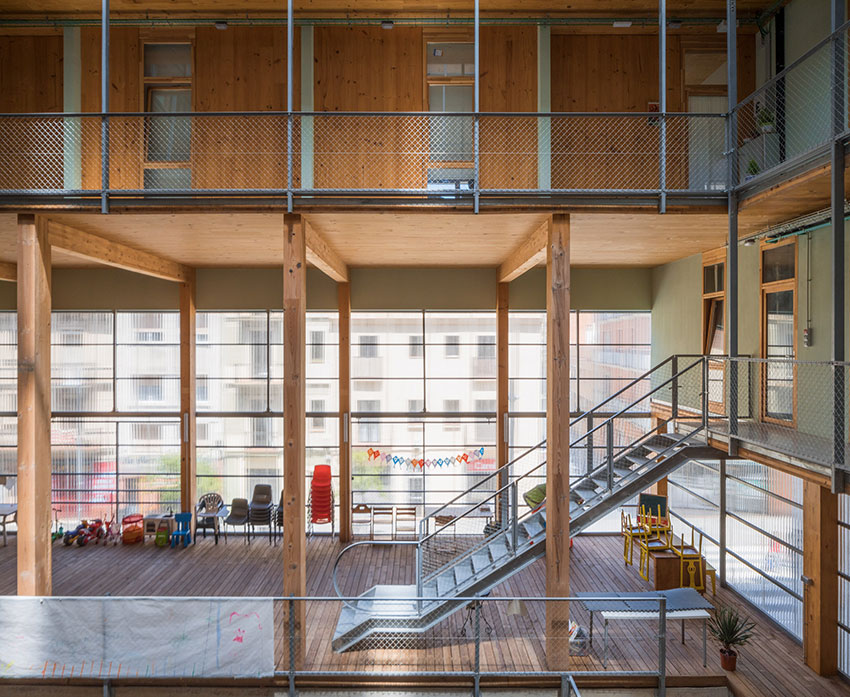
Photo courtesy of Lluc Miralles, courtesy Lacol Arquitectura Cooperativa
La Borda Cooperative
The process aligns with La Borda’s values: “active participation, collective ownership, affordability, and sustainability.” Just as each member of La Borda’s collective serves a purpose and a role, so, too, do the architectural elements.
The Spanish cross-laminated timber infuses the building with a natural and organic ambience. Cristina Gamboa, a cooperative member, explains that they “tried to have a more global understanding of the implications of this material decision,” with mass timber offering a climate-friendly alternative to more energy-intensive materials. And, at its heart, a central courtyard unifies the building, creating a flexible meeting area that invites residents to gather, connect, and socialize.
Finding Common Ground | Lubber Run Community Center, Arlington, Virginia
The Lubber Run Community Center is an expanse of lush green space that draws you toward the net-zero center at its core. The building emerges organically out of the park and features a living roof adorned with trees and park benches. Initially, local residents were set on plans for a three-to-four-story building, tucked into the background of the surrounding park. To find common ground, the design team undertook a lengthy participatory design process that lasted an entire year. Jay Fisette, former Arlington County Board chairperson, says that “there was lots of community involvement and excitement surrounding the new design and plan.”
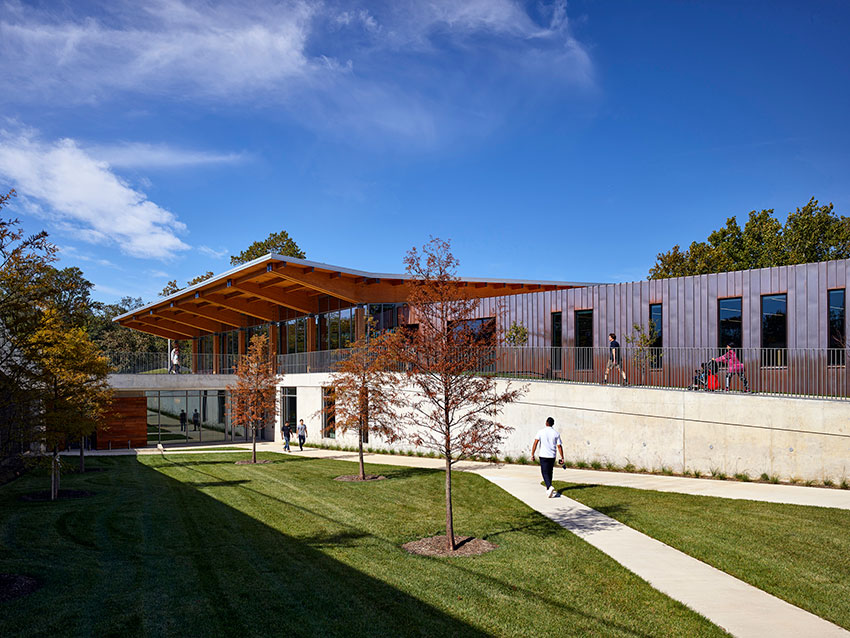
Photo courtesy of Tom Holsworth, courtesy VMDO Architects
Lubber Run Community Center
Designing a replacement to the original 1950s-era community center presented a challenge for VMDO Architects. Community members felt strongly that park space be maximized and building space minimized. Yet, through community engagement, the VMDO team was able to demonstrate how architecture can integrate and blend building and landscape, “ultimately creating public space that is greater and greener for residents.”
Nina Comiskey, architect at VMDO, says, “This was about understanding what the community wants, rather than specific design guidelines. We were able to guide [the people of Arlington] to a better way of getting what they wanted.”
Lubber Run’s design focused on promoting equitable access to the center and the park and engaging cross-generational communities and hard-to-reach groups. A series of workshops, meetings, online feedback sessions, and on-site engagement activities contributed to the project vision.
A Modern Barn Raising | Barn Pavilion, Sacramento, California
Placemaking can revitalize underused urban areas, inviting social connections between diverse citizens and demographics. Located in Sacramento’s once-struggling Bridge District, the Barn Pavilion is a modern take on a community barn raising. The sinuous, wood-shingle-clad timber structure, now known simply as the Barn, gives new life to Sacramento’s once-deteriorating Bridge District.
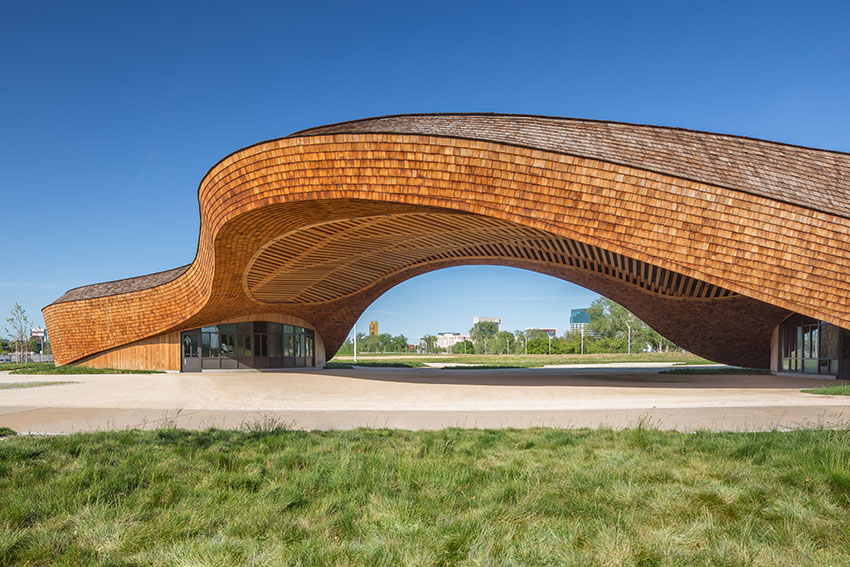
Photo courtesy of Chad Davies
The Barn
The Barn features a curvilinear design that emerges out of the pavement, welcoming passersby into its shaded nooks. The public plaza below the Barn hosts gatherings, while inside you can shop, wine and dine, or wander, making your way out to the extensive open-air breezeway. The Barn’s multifunctionality and warm organic atmosphere turns this public space into a community place that is both beautiful and functional. Its fluid, sculptural form makes for ambidextrous architecture, adaptive to a multitude of uses.
Design choices can have big impacts on community health and well-being—a well-designed building or public space can foster a sense of belonging by creating third places between work and home that invite social connection and interaction. In particular, participatory design invites community engagement and responsibility. By centering the community at the heart of the design process, participatory design can foster community ownership and pride.
Designing For Density: A Built Environment To Accommodate Growing Populations
The Rising Need for Affordable Housing and Mixed-Use Development
For community building and placemaking to thrive, cities need safe, accessible, and affordable housing, inclusive of a broad socioeconomic spectrum of people. This is becoming even more imperative as urban population growth surges.
By 2050, two-thirds of the world’s population will live in urban areas. Outside traditional city centers, urban-adjacent suburbs and mid-sized cities and towns also are seeing rapid growth, fueled in part by a shift to remote working in response to the COVID-19 pandemic. As a result, the demand for affordable housing is outpacing supply, with new multifamily units renting at prices that are cost-prohibitive for middle- and low-income renters.
Without cost-effective housing options—and a diverse mix of units from rentals and cooperatives to social and market housing—urban centers risk becoming destinations for “global elites.” In some cases, high-priced investment properties sit empty while a rapidly rising population can’t find housing. Nearly two-thirds of renters nationwide say they can’t afford to buy a home, and saving for a down payment is out of reach when home prices are rising at twice the rate of wage growth. These challenges, compounded by a global pandemic, have only intensified America's housing problems.
At the same time, infrastructure, amenities, and mixed-use commercial space is needed to support population growth. But land available for such development is costly and scarce, highlighting the need to optimize the use of existing space in urban centers. And now, these same cities must consider how to adapt mixed-use development for a post-pandemic world.
Given all these challenges, how can developers, architects, and contractors boost affordability and reduce multifamily housing costs? How can they make better use of available land and optimize the use of existing mixed-use commercial spaces?
What Impact Can Design Teams Have On Density and Affordability?
To answer these questions, designer and urbanist Hannah Hoyt, Gramlich Fellow at Harvard University’s Joint Center for Housing Studies, interviewed 30 professionals working in the development sector.
The findings? To help make housing more affordable, the report recommends design teams consider multiple strategies that can curb development costs in three categories: land costs, soft costs, and hard costs, with a focus on what savings are within their day-to-day control and can be passed on to occupants.
Land costs refer to the cost of acquiring land—and amounts to approximately 10-20 percent of total development costs for a typical multifamily project. Examples of strategies to maximize land value include selecting a site that offers economies of scale, considering design solutions for oddly shaped lots or scattered sites, and renovating, converting, or co-locating housing with existing buildings.
A standard approach to site evaluations that considers everything from soil and site clearance to grade and zoning can, according to the report, go a long way to identifying scalability and avoiding unexpected site preparation costs.
Hard costs are the costs of construction, which can be divided into four subcategories: substructure and site prep, shell and structure, interiors, and services. Hard costs amount to 50-70 percent of total costs. Examples of strategies that can have a positive impact on hard costs include designing units for maximum flexibility and efficiency, investigating new techniques and materials, and investing in energy and water performance to realize long-term savings for a project.
Finally, soft costs include all other costs—financing, design, engineering, permitting, and any impact fees. In this category, engaging general contractors early and as partners can help realize savings, and sharing more information with subcontractors can result in more accurate cost estimating.
Case Studies: Making Housing And Mixed-Use Density More Affordable
There are a growing number of multifamily and mixed-use projects across the country using such strategies to tackle the challenges of density and affordability.
Affordable Housing in Portland, Maine
On the opposite coast, architect CWS Architects and general contractor Zachau Construction are adopting similar tactics in their affordable housing project, Wessex Woods. It’s a four-story, 40-unit, affordable senior housing development for Avesta Housing in the Nason’s Corner neighborhood of Portland, Maine.
By using mass timber, the team cut the hard costs related to long-drawn-out construction schedules.
“Traditionally it’s always been CMU (concrete masonry unit) for elevators and stairs,” said Ben Walter, president at CWS Architects. “But we were able to demonstrate that a new material, and a different set of details to install it, fit nicely here.”
They compressed the shaft’s expected three-week construction time to one day, reducing their budget by $75,000, while realizing additional cost savings related to lower labor, heating, and tenting requirements.
Drew Wing, chief operating officer at Zachau Construction, witnessed the project’s time-saving benefits of CLT and wood panel construction firsthand. “In addition to erecting stair towers and elevator shafts in a day, it also allowed the framing of the building to happen concurrently, something we could not have done with masonry,” said Wing. “We were also able to lift and crane the panelized components into place easily, saving an enormous amount of time on the project schedule overall.”
“The design team, construction manager, and owner all worked together. That's what allowed CLT to happen in this fashion,” Wing added.
Mixed-Use Infill Project in Atlanta
Infill housing and mixed-use development is a powerful way to bring more housing and amenities to community areas while enriching and blending with existing neighborhood culture and appearance.
The architects of the Emory Point project, a vibrant, mixed-use apartment complex in Atlanta, employed a number of strategies to create an affordable solution that also boosted density.
The property’s central location maximizes what they can do with the site. Its access to public transit ensures that residents can live comfortably without a car, reducing local traffic and carbon emissions, as well as the need for parking.
By building with wood—which allows for prefabrication off-site and quick construction—the developers met an aggressive schedule resulting in significant cost reductions for labor and construction.
“Cost for the structural frame portion of the building only was about $14 per square foot,” according to Brad Ellinwood, engineer on the project. “In comparison, a 7-inch post-tensioned concrete slab and frame would have cost $22 per square foot. So, the wood-framing option yielded about 35 percent savings in the structure.”
Building on Top: Innovative Use of Urban Space in Washington, D.C.
Another creative solution to space constraints and making the best use of urban sites is to build on top of already existing buildings—adding stories to established structures, allowing for higher density while retaining the economic value and historical significance of the original building footprint. Mass timber’s light weight opens new opportunities for overbuild construction. The 80 M Street addition in Washington, D.C., is creating additional office spaces, meeting areas, a beautiful rooftop terrace, and gathering places on top of an existing seven-story office building.
From Carbon Source To Carbon Sink: Redesigning The Built Environment For Climate Change
Amidst the urgent need for affordable housing and urban infrastructure, the culminating impacts of a changing climate demand dramatic shifts in how we design and construct our buildings. One important part of the solution—convert the built environment from a significant carbon source to a carbon sink.
The Urgent Need to Lower Building Carbon Footprints
Climate change demands dramatic shifts in how we design and construct our buildings. At the same time, the urgent need for housing and supportive infrastructure continues to surge at record rates. Buildings and their construction account for 39 percent of global carbon dioxide emissions, of which 28 percent come from operational carbon—the energy used to power, heat, and cool a building. Buildings’ operational carbon can be reduced through energy efficiency measures, and policymakers, architects, developers, and engineers have made significant advances in this arena. The remaining 11 percent of carbon emissions are generated from building materials and construction. This “embodied carbon” can account for half of the total carbon footprint over the lifetime of the building.
To reduce the greenhouse gas emissions associated with construction, specifiers and stakeholders need to act now to create embodied carbon strategies that reduce environmental impacts from buildings we’ll use well into the future. The costs of delaying any longer are too high. Greenhouse gas emissions have increased by 90 percent since 1970. A 1.5 percent increase in global warming will have catastrophic results for ecosystems and people around the world, including the United States.
Embodied carbon is a priority for many environmental, architecture, and urban planning organizations including C40 Cities, Architecture 2030, Urban Land Institute, and the World Green Building Council. Many experts believe addressing embodied carbon for buildings and building materials is critical to achieve the goals of the Intergovernmental Panel on Climate Change (IPCC) and the 2016 Paris Climate Agreement.
Embodied Carbon in a Building’s Life Cycle
Embodied carbon is determined by conducting a life cycle assessment (LCA) of a product, assembly, or the building over declared life cycle stages. An LCA study returns results for a number of environmental metrics, including the potential to impact climate, or “global warming potential (GWP)." Embodied carbon is the GWP result. Embodied carbon is measured for each stage of the product’s life cycle, allowing comparisons across any combination of stages.
As buildings become more energy efficient, the upfront embodied carbon from materials begins to account for a higher proportion of a building’s carbon footprint. Very soon, embodied carbon is likely to become the dominant source of building emissions.
Embodied carbon varies dramatically between concrete, steel, and wood, making product decisions key in achieving lower carbon buildings. Manufacturing wood products requires less total energy, and in particular less fossil fuel energy, than manufacturing most alternative materials including metals, concrete, or bricks.
Embedded Carbon in Wood Products
Embedded carbon is the storage of carbon for long periods of time. Wood products are approximately 50 percent carbon by dry weight. And wood’s lightweight advantage when it comes to density and city building is making it an attractive, climate-smart choice as pointed out in a research paper: “Lightweighting with Timber: An Opportunity for More Sustainable Urban Densification.” The use of wood products in buildings provides an additional environmental benefit by storing carbon removed from the atmosphere. This ability to sequester, or “embed," carbon makes wood an ideal product for buildings, which are designed for long service lives. Essentially, a wood building is a large carbon sink. This storage of carbon is a unique environmental attribute that does not exist in other structural products.
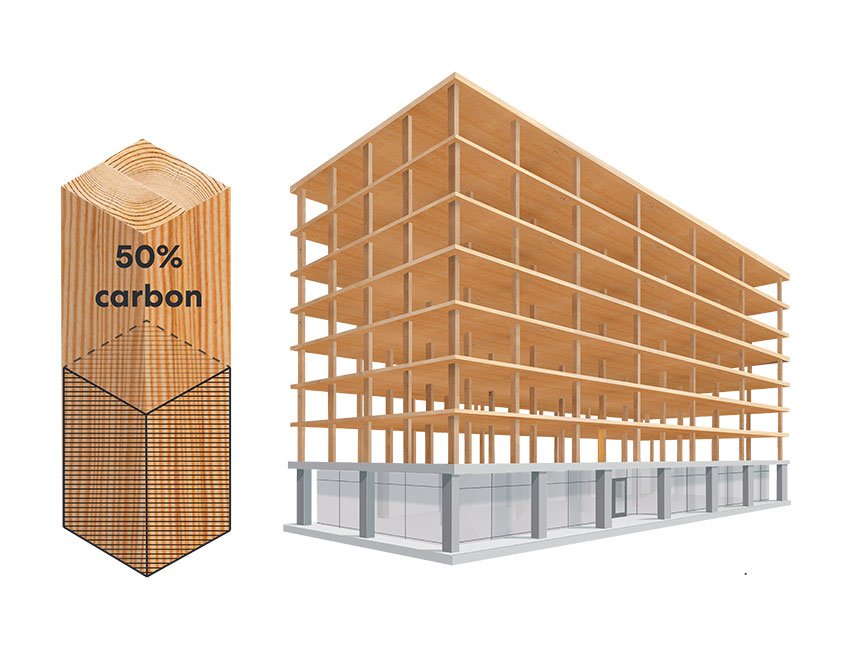
Photo courtesy of ThinkWood
Embedded carbon
Timber as a tactic for curbing climate change is backed by a growing body of research and advancements in calculating the carbon footprint of building materials. In a recent paper published in the journal Nature Sustainability, experts at the Potsdam Institute for Climate Impact Research in Germany delved into four possible scenarios of timber use in buildings over the next 30 years. In the first case, “business as usual,” 0.5 percent of buildings are made with wood while the vast majority remain constructed of concrete and steel. There’s a 10 percent timber building scenario, a 50 percent timber building scenario, and a fourth scenario in which the vast majority—90 percent of new construction—is made with wood. Their findings suggest that the lowest scenario could result in 10 million tons of carbon stored per year, and in the highest, nearly 700 million tons. “Buildings, which are designed to stay for decades,” researchers write in the paper, “are an overlooked opportunity for a long-term storage of carbon, because most widely used construction materials such as steel and concrete hardly store any carbon.”
While the research is limited to European wood construction, the authors of the study see global potential. “This is the first time that the carbon storage potential of wooden building construction has been evaluated on the European level, in different scenarios,” said Ali Amiri, one of the researchers of the study. “We hope that our model could be used as a road map to increase wooden construction.”
Case Studies: Carbon and Climate
Design professionals across the country and around the world are increasingly constructing buildings using light-frame and mass timber structures in a commitment to combat climate change. Not only does wood continue to store carbon, its insulative thermal properties lend well to energy efficient solutions like Passive House.
Mass Appeal: CLT Passive House Demonstration Project
A Boston-based CLT Passive House Demonstration Project is a mass timber, mid-rise, multifamily, certified Passive House building that shows how cross-laminated timber systems can meet complex design and sustainability goals. It’s the brainchild of MIT start-up Generate and design-build firm Placetailor.
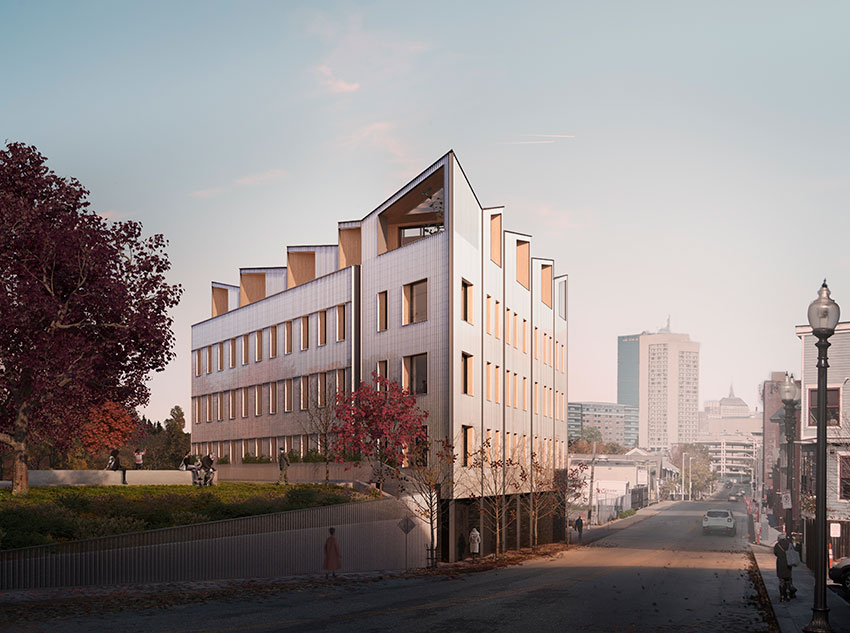
Photo courtesy of Generate, Placetailor
Model-C
“Mass timber buildings, like Model-C, have the ability to tackle climate change [and] are also mid-rise to accommodate urban density,” says Generate CEO, John Klein.
The five-story, mixed-use demonstration project is Boston’s first full cross-laminated timber (CLT) building, housing 14 residential units and a ground floor coworking space. The project was designed to operate at net-zero carbon, which is achieved by calculating both the building’s embodied energy and its operational energy, and offsetting any annual excess energy use through carbon offset purchases. The building is Passive House-certified and meets the Boston Department of Neighborhood Development’s Zero Emission Standards.
High-Density, Mid-Rise, Light-Frame Construction: Yobi Microhousing
Today’s wood-frame buildings can offer more affordable housing options. Four-to-six-story wood-frame structures are a sweet spot for urban infill and neighborhood densification—helping to pencil out housing in bigger cities with rising costs. An excellent example is Seattle-based Yobi Microhousing.
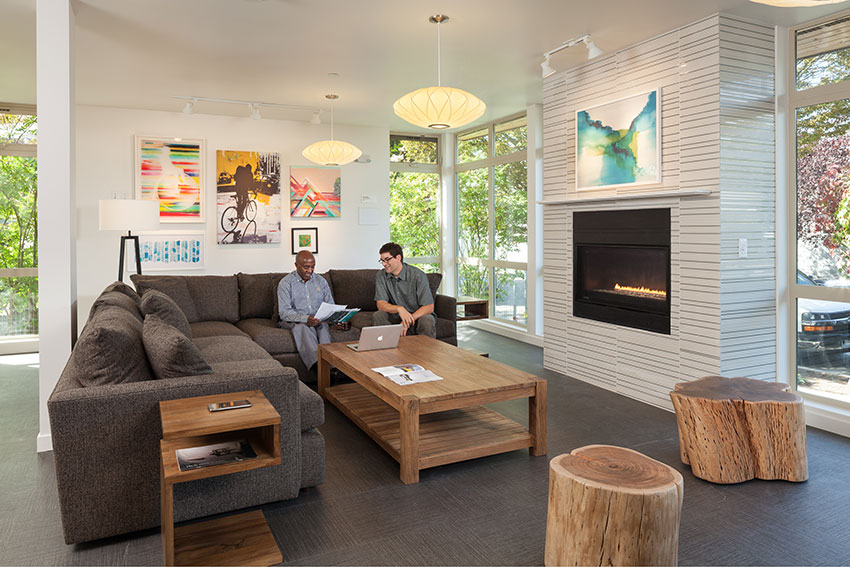
Photo courtesy of © 2015 William P. Wright
Yobi Microhousing
A central strategy in the Yobi project is the creation of shared common space that contributes to an efficient building footprint. Conventional wood-frame construction with dimensional lumber shear walls combined with high insulation levels and sealed openings to create a high performance exterior envelope for the project with energy use that is 40 percent lower than current energy code requirements.
The 13,689-square-foot, four-story structure accommodates 40 sleeping units built over a partially-below-grade basement. A ground floor provides common areas including a lounge, community kitchen, laundry area, and media room.
“Wood makes it much easier to build an efficient envelope,” says David Neiman, a principal architect for the project. Based on energy use per person, Yobi is 70 percent more energy efficient than conventional housing, according to Neiman.
Climate-Friendly Educational Design
Offering lessons in sustainability, more and more of today’s education design—from elementary to post-secondary—showcases climate-smart, low-carbon strategies.
At Billerica Memorial High School, timber contributes to the building’s carbon-conscious design. Embodied carbon in the Forest Stewardship Council-certified spruce timber structure offsets the equivalent of a typical school bus traveling over 460,000 miles.
The 30,000-square-foot Billerica, Massachusetts-based facility, designed by Perkins&Will, elegantly combines wood, steel, and glass, to give a modernist nod to its neighboring neoclassical civic buildings, while delivering a high-tech, future-ready educational environment.
T3: Low-Carbon Commercial Construction
Standing seven stories tall, T3 (Timber, Transit, Technology) was the first commercial property in the U.S. to use timber for its structure and interior finishing. It demonstrates how large timber projects can lower the carbon footprint of the built environment while providing a warm and innovative commercial space. The 220,000-square-foot building was constructed with 8-by-20-foot panels of wood that were stacked across beams of glued, laminated timber. The panels themselves were constructed using dimensional lumber.
Approximately 2.2 million board feet were used in the structure, which will sequester about 700 tons of carbon for the life of the building. It was also built in significantly less time than conventional steel-framed or concrete buildings, completed in just two and a half months at an average of nine days per floor.
Given timber’s light weight, lower production time, and lower costs, T3 developer Hines has replicated this building prototype in Atlanta, with plans to expand to other markets including Chicago, Denver, Toronto, and Melbourne.
Architecting Change: Reasons For Optimism
As design professionals look to the decade ahead, there are many challenges on the horizon, from addressing pressing environmental and social issues to accommodating rapid population growth and shifting market demands. There is a growing understanding that the built environment is inextricably linked to many of the complex issues of our day. While these problems are global in scale and, in some cases, beyond the influence of the AEC industry alone, there are actions design professionals are taking in their day-to-day practice that can begin to make an impact.
A rapidly evolving, post-pandemic world demands adaptive and versatile design professionals who are continually evolving their practice and looking to the latest research and methodologies to help inform their design solutions. Design teams are showing how we can boost health, affordability, and wellness in today’s increasingly dense urban environments through creative, nimble, and flexible thinking.
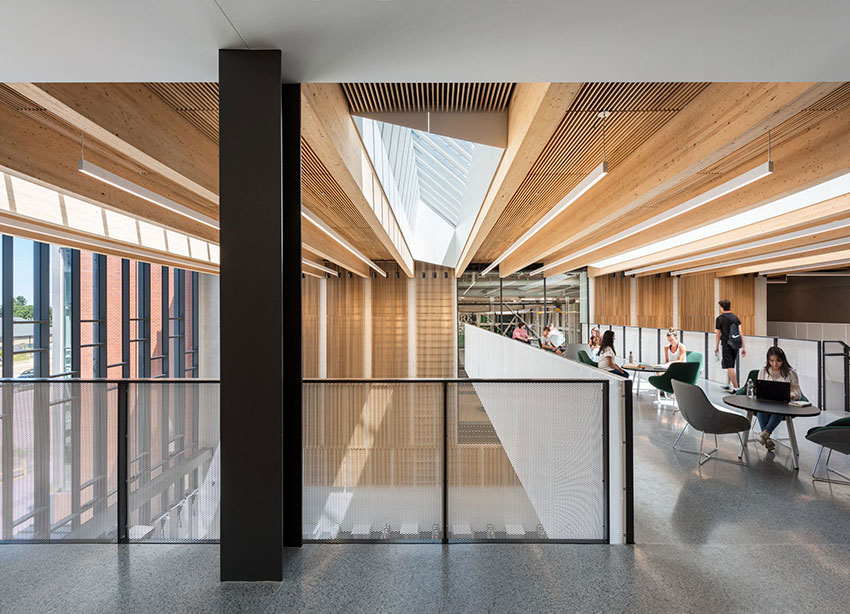
Photo courtesy of Chuck Choi, Perkins&Will
Billerica Memorial High School
There is also an urgent need to combat climate change and find advanced ways to store carbon in our buildings. Industry leaders are stepping up with substantial commitments—from conducting leading research on carbon and climate to erecting important demonstration projects. Structural timber is proving to be one significant way to sequester embodied carbon and reduce the environmental footprint of new construction. Ingenuity and smart design can also mitigate the impacts of global warming. Interweaving greenspace into the urban environment, as well as within buildings and on top of them, can have a cooling effect on our cities.
Industry leaders are committing to building for a resilient, healthy, and low-carbon future—an ‘architecture of optimism.’ Jordan Goldstein, a design principal at Gensler writes, “Whether it’s new buildings that are about to be designed or existing architecture that now needs to be reimagined, in many ways this is a time for an architecture of optimism. Optimistic architecture isn’t architecture for the sake of architecture and doesn’t seek to glorify form. Rather, it’s an architecture that seeks to express its purpose in every aspect of the design—one that promotes wellness and celebrates life. The time to define this architecture of optimism is now. The future of our cities depends on it.”
End Notes
1 Climate change: Last decade confirmed as warmest on record,according to the data of three global agencie bbc.com
2 New report: the building and construction sector can reach net zero carbon emissions by 2050, World Green Building Council, www.worldgbc.org
3 http://www.freddiemac.com/research/insight/20181205_major_challenge_to_u.s._housing_supply.page?
4 America’s Exceptional Housing Crisis, September 2020, https://www.foreignaffairs.com/articles/united-states/2020-09-14/americas-exceptionalhousing-crisis
5 World Economic Forum, The cost of housing is tearing our society apart, https://www.weforum.org/agenda/2019/01/why-housing-appreciation-is-killinghousing/; The Economist, Housing is at the root of many of the rich world’s problems, https:/ www.economist.com/special-report/2020/01/16/housingis- at-the-root-of-many-of-the-rich-worlds-problems; Curbed, The affordable housing crisis, explained, https://archive.curbed.com/2019/5/15/18617763/ affordable-housing-policy-rent-real- estate-apartment
6 We spend 90% of our time inside—why don’t we care that indoor air is so polluted?, https://www.fastcompany.com/90506856/we-spend-90-of-our-timeinside- why-dont-we-care-that-indoor-air-is-so-polluted
7 Zero-carbon buildings are possible following these four steps, https://www.weforum.org/agenda/2020/01/zero-carbon-buildings-climate/
8 MIT Architects Use Wood To Make First Net Zero Energy Building In Boston, https://buildingandinteriors.com/mit-architects-use-wood-to-make-first-netzero-energy-building-in-boston/
9 Proposed 80-story wooden skyscraper may be a preview of tall timber future, https://archive.curbed.com/2017/10/9/16449494/tall-timber-buildingskyscraper
10 Urban green spaces and heath, a review of evidence, https://www.euro.who.int/__data/assets/pdf_file/0005/321971/Urban-green-spaces-and-healthreview-evidence.pdf?ua=1
11 ResilientCity.org, https://www.resilientcity.org/index.cfm?id=11449
12 Green Space is Good for Mental Health, https://earthobservatory.nasa.gov/images/145305/green-space-is-good-for-mental-health
13 Shinrin-Yoku (Forest Bathing) and Nature Therapy: A State-of-the-Art Review, https://www.ncbi.nlm.nih.gov/pmc/articles/PMC5580555/
14 A review of psychological literature on the health and wellbeing benefits of biophilic design, https://www.mdpi.com/2075-5309/5/3/948
15 Gardenhouse, https://gardenhousebh.com/
16 Tips to Combat Heat Island Effect Around Your Building, https://www.buildings.com/podcasts/15338/tips-combat-heat-island-effect-around-your-building
17 Drs. Julian and Raye Richardson Apartments, https://chp-sf.org/housingservices/housingproperties__trashed/drs-julian-and-raye-richardsonapartments/
18 Nature in Cities in a Post-Covid-19 World: Don’t Blame Urban Density in a Pandemic https://www.thenatureofcities.com/2020/09/03/nature-in-cities-in-apost-covid-19-world-dont-blame-urban-density-in-a-pandemic/
19 Why Participatory Design? http://participateindesign.org/approach/why
20 Participatory Design: A new Approach to Regenerate the Public Space, International Journal of Architecture and Urban Development, Autumn 2014, http://ijaud.srbiau.ac.ir/article_8339_47703dce2ed5f9ebcac51ce275b56d74.pdf
21 Sustainable building, sustainable living: La Borda, Barcelona by Lacol, Architects’ Journal, George Kafka, June 2020, https://www.architectsjournal.co.uk/buildings/sustainable-building-sustainable-living-la-borda-barcelona-bylacol
22 Lubber Run Community Center, https://www.vmdo.com/lubber-run-communitycenter.html
23 Lubber Run Community Center, VMDO Architecture, https://www.vmdo.com/lubber-run-community-center.html
24 Lubber Run Community Center, VMDO Architecture, https://www.vmdo.com/lubber-run-community-center.html
25 Eleven Principles for Creating Great Community Places, The Project for Public Spaces, https://www.pps.org/article/11steps
26 11 principles of placemaking, Placemaking Chicago, http://www.placemakingchicago.com/about/principles.asp
27 The Barn, https://www.thinkwood.com/projects/the-barn
28 Why the ‘third place’ is revolutionising the way we work, Indesign Live, Pia Sinha, July 2019, https://www.indesignlive.com/the-ideas/third-placerevolutionising-work
29 https://www.cmap.illinois.gov/onto2050/snapshot-reports/placemaking
30 Urbanization, Our World in Data, https://ourworldindata.org/urbanization
31 The rise of midsized cities, Freedom Lab, https://freedomlab.org/the-rise-ofmidsized-cities/
32 5 Big Picture Trends Being Accelerated by the Pandemic, https://www.visualcapitalist.com/5-big-picture-trends-being-accelerated-by-the-pandemic/
33 More for Less? An Inquiry into Design and Construction Strategies for Addressing Multifamily Housing Costs, https://www.jchs.harvard.edu/sites/default/files/media/imp/harvard_jchs_gramlich_design_and_construction_strategies_multifam ily_hoyt_2020_3.pdf; Yes, Your Rent Is Too Damn High, https://www.vice.com/en/article/neammm/yes-your-rent-is-too-damn-high-heres-what-2020-democrats-want-to-doabout-it
34 Is Your City Being Sold Off to Global Elites?, https://www.motherjones.com/politics/2017/05/hedge-city-vancouver-chinese-foreign-capital/
35 Why Manhattan’s Skyscrapers Are Empty, https://www.theatlantic.com/ideas/archive/2020/01/american-housing-has-gone-insane/605005/ ;Empty homes study reveals 10,000 vacant condos but still fails to explain Vancouver realestate prices, https://www.straight.com/news/653356/empty-homes-studyreveals-10000-vacant-condos-still-fails-explain-vancouver-real-estate
36 More Renters Give Up on Buying a Home, https://www.wsj.com/articles/morerenters-give-up-on-buying-a-home-1522773685
37 Home prices are rising faster than wages in 80% of U.S. markets, https://www.housingwire.com/articles/47878-home-prices-are-rising-faster-than-wages-in-80-of-us-markets/
38 The Harvard Joint Center for Housing Studies releases its 2020 State of the Nation’s Housing report, https://www.jchs.harvard.edu/sites/default/files/interactive-item/files/Harvard_JCHS_State_Nations_Housing_2020_Press_Release.pdf
39 Redesigning Mixed-Use Environments for a Post-Pandemic World, https://www.gensler.com/research-insight/blog/redesigning-mixed-use-environments-for-apost-pandemic-world
40 More for Less? An Inquiry into Design and Construction Strategies for Addressing Multifamily Housing Costs, https://www.jchs.harvard.edu/sites/default/files/media/imp/harvard_jchs_gramlich_design_and_construction_strategies_multifamily_hoyt_2020_3.pdf
41 Making apartments more affordable starts with understanding the costs of building them, https://www.brookings.edu/research/making-apartments-moreaffordable-starts-with-understanding-the-costs-of-building-them/
42 More for Less? An Inquiry into Design and Construction Strategies for Addressing Multifamily Housing Costs, p. 34-35 https://www.jchs.harvard.edu/sites/default/files/media/imp/harvard_jchs_gramlich_design_and_construction_strate gies_multifamily_hoyt_2020_3.pdf
43 Ibid, pg.52, 64, 72
44 More for Less? An Inquiry into Design and Construction Strategies for Addressing Multifamily Housing Costs, p.40 https://www.jchs.harvard.edu/sites/default/files/media/imp/harvard_jchs_gramlich_design_and_construction_strategies_multi- family_hoyt_2020_3.pdf
45 New report: the building and construction sector can reach net zero carbon emissions by 2050, World Green Building Council, https://www.worldgbc.org/news-media/WorldGBC-embodied-carbon-report-published
46 https://www.worldgbc.org/sites/default/files/UNEP%20188_GABC_en%20%28web%29.pdf
47 https://2os2f877tnl1dvtmc3wy0aq1-wpengine.netdna-ssl.com/wp-content/uploads/ULI-Documents/Greenprint-Embodied-Carbon-Report_FINAL.pdf; https://americas.uli.org/wp-content/uploads/sites/2/ULI-Documents/Greenprint-Embodied- Carbon-Report_FINAL.pdf
48 https://www.epa.gov/ghgemissions/global-greenhouse-gas-emissions-data
49 https://www.ipcc.ch/sr15/
50 https://www.c40.org/
51 https://architecture2030.org/new-buildings-embodied/
52 https://americas.uli.org/wp-content/uploads/sites/2/ULI-Documents/Greenprint-Embodied-Carbon-Report_FINAL.pdf
53 https://www.worldgbc.org/embodied-carbon
54 http://www.athenasmi.org/wp-content/uploads/2015/09/Advancing_Sustainable_Design_with_LCA.pdf
55 https://www.canfor.com/docs/why-wood/tr19-complete-pub-web.pdf, pg. 3
56 FPInnovations and Think Wood: The Impact of Wood Use on North American Forests
57 Lightweighting with Timber: An Opportunity for More Sustainable Urban Densification, Journal of Architecture Engineering, Robert Foster and Thomas Reynolds, https://www.researchgate.net/publication/322732544_Lightweighting_with_Tim ber_An_Opportunity_for_More_Sustainable_Urban_Densification
58 https://www.fastcompany.com/90574889/wood-buildings-should-be-arequirement-of-any-climate-change-policy
59 N.B. Growing body of research and practical studies exploring the benefits of timber include but not limited to: Buildings can become a global CO2 sink if made out of wood instead of cement and steel; High-rise Timber Buildings as a Climate Change Mitigation Measure – A Comparative LCA of Structural System Alternatives; Carbon footprint of prefabricated wood buildings
60 N.B. Cities as carbon sinks—classification of wooden buildings: This study aims to estimate the carbon storage potential of new European buildings between 2020 and 2040. While studies on this issue exist, they mainly present rough estimations or are based on a small number of case studies. To ensure a reliable estimation, 50 different case buildings were selected and reviewed. Results estimate a gradual increase of wood in new buildings over the course of two decades, and specifically at the average amount of new housing built annually in Europe. The researchers found that stored carbon could hit a total of 420 million tons by 2040. While there are opportunities for wood harvesting in the world. It should be noted that wood harvesting is only reasonable if forests are managed efficiently. Otherwise, using wood for construction will result in the disappearance of forests. Read the full study here.
61 Cities as carbon sinks—classification of wooden buildings, https://iopscience.iop.org/article/10.1088/1748-9326/aba134
62 Building with timber instead of steel could help pull millions of tons of carbon from the atmosphere, Fast Company, https://www.fastcompany.com/90456328/building-with-timber-instead-of-steel-could-help-pull-millionsof-tons-of-carbon-from- the-atmosphere
63 Others corroborate their findings such as a Canadian-based study examined the carbon footprint of prefabricated wood buildings. Using a multi-story timber residential building in Quebec City as their baseline, the study uses life cycle assessment to quantify the potential of mass timber to avert emissions. Their findings: the baseline scenario produces 25% fewer emissions than a conventional building and 38% fewer emissions when using additional carbon reduction strategies. This study and its findings are limited to the evaluation of one baseline building. The additional carbon reduction strategies included 1) low carbon materials, 2) material minimization, 3) reuse and recycling strategies and 4) local sourcing and transport minimization. Read the full study and limitations: https://www.researchgate.net/publication/320601003_Carbon_footprint_of_pre-fabricated_wood_buildings
64 The Impact of Wood Use on North American Forests, https://www.thinkwood.com/education/impact-wood-use-north-american-forests
65 Billerica Memorial High School, Perkins and Will, https://perkinswill.com/project/billerica-memorial-high-school/
66 https://www.thinkwood.com/our-projects/t3-timber-transit-technology
67 https://www.hines.com/properties/t3-rino-denver
68 Examples demonstrating this include: The Built Environment and Its Relationship to the Public’s Health: The Legal Framework, https://www.ncbi.nlm.nih.gov/pmc/articles/PMC1447979/; This is how we can get real value from infrastructure, https://www.weforum.org/agenda/2020/09/how-we-can-getreal-value-from-infrastructure/; Intersections: Health and the Built Environment, https://uli.org/wp-content/uploads/ULI-Documents/Intersections-Health-andthe- Built-Environment.pdf
69 Support for this concept is evident in: Why architects matter in a postpandemic world, https://www.aia.org/articles/6295249-why-architectsmatter-in-a-post-pandemic-w; How the COVID-19 Pandemic Will Change the Built Environment, https:// www.architecturaldigest.com/story/covid-19-design; The next normal in construction, https://www.mckinsey.com/~/media/McKinsey/Industries/Capital%20Projects%20and%20Infrastructure/Our%20Insights/The%20next%20normal%20 in%20construction/The-next-normal-inconstruction.pdf
70 An Architecture of Optimism for a Post-Pandemic Society, https://www.gensler.com/research-insight/blog/an-architecture-of-optimism-for-a-post-pandemicsociety





















